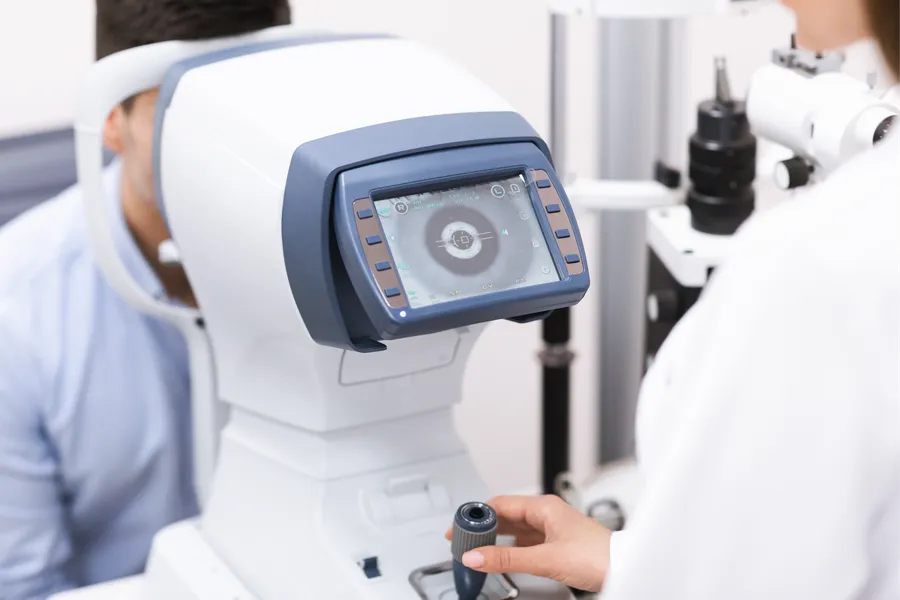About this course
Professional boundaries mean safer practice, clearer decisions, and stronger patient trust.

[podcast mini /media/goc-standard-6-intro.mp3]
You’re in the middle of a busy clinic, a patient presents with something unusual, and for a moment you’re unsure—should you manage this yourself, or is it safer to refer? That pause, that moment of reflection, is at the very heart of GOC Standard 6. It’s not about knowing everything; it’s about knowing your limits, recognising when to seek support, and making decisions that put patient safety first.
Competence is more than technical skill. It’s your knowledge, your judgement, your ability to communicate clearly, and your professional behaviour under pressure. This course will help you strengthen those qualities, so you can act with confidence, clarity, and integrity—even when faced with complex or unexpected cases.
Remember, referral isn’t a failure; it’s a safety tool. By working within your limits, documenting your actions, and expanding your scope responsibly through supervision and CPD, you not only protect your patients—you also protect your professional standing. This journey is about resilience, responsibility, and pride in safe practice.
Good care depends on knowing when to act - and when to seek support. This course gives you practical tools to recognise your limits, manage risk appropriately, and refer confidently when needed. You will learn how to apply GOC Standard 6 in everyday practice with assurance.
This course is relevant to the whole optical team, including
- Registered optical professionals wanting reliable CPD mapped to GOC Standards
- Locums, jobseekers, and overseas practitioners needing to demonstrate current knowledge
- Colleagues addressing professional challenges who require structured CPD for reflection and remediation
- Managers and teams who want consistent, defensible training
CPD Time: 60 minutes (1 CE Credit / 1 Non-interactive CPD Point)
Assessment: 10 MCQs. Pass mark 80%. more…
On passing the assessment you will immediately receive a CPD Certificate.
Customer feedback on this course
- Clear, practical guidance that I use at the chairside.
- Useful decision aid for referrals — simple and evidence based.
- Good coverage of communication needs and when to use interpreters.
- Helpful templates for referrals and documentation — saved me time.
- Reassuring advice on refusing unsafe requests and escalating concerns.
Aim:
The aim of this course is to ensure optical professionals understand and apply GOC Standard 6 by recognising personal limits of competence and acting to protect patients through safe escalation, referral, and documentation.
Course objectives:
- Clarify professional competence in optical practice and provide decision tools for safe escalation, referral, communication, and accountability.
- Equip learners to plan supervised CPD and use reflective practice to expand competence while maintaining patient safety.
Anticipated learning outcomes:
On course completion you will be able to:
- Identify personal limits of knowledge, skills, and experience (Standard 6) and act within them to protect patients.
- Explain when and how to escalate or refer patients (Standard 6), matching urgency to clinical risk and using clear communication with patients and colleagues.
- Record and justify decisions (Standard 6) while planning targeted CPD or supervised practice to expand competence safely.
GOC Framework Mapping:
Standard 6: Working Within Your Limits of Competence
Domain: Clinical Practice
Learning content:
Introduction: Why Competence Matters | Defining Competence | Scenario Page 1: Clinical Limits | Legal and Professional Framework | Safe Escalation and Referral | Scenario Page 2: Communication and Cultural Competence | Expanding Competence Safely | Scenario Page 3: Professional Boundaries | Reflection and Continuous Growth | MCQ | Reading List
GOC Standard 6: Working Within Your Limits of Competence in Optical Practice
Course Description
Introduction: Why Competence Matters
This section explains patient safety, professional accountability and the core expectations of GOC Standard 6. It covers legal duty of care and indemnity implications.
Defining Competence
Define competence across knowledge, skills and judgement. Learn about communication and cultural competence, limits of practice and the role of continuous professional development.
Scenario Page 1: Clinical Limits
Apply the principles to common clinical scenarios: complex retinal signs, outdated specialist skills and choices between referral and local management. Emphasis on documentation and reflection.
Legal and Professional Framework
Review GOC expectations, employer duties, indemnity coverage and the risks of practising beyond competence.
Safe Escalation and Referral
When and how to refer, matching urgency to risk, writing clear referrals and explaining escalation to patients. Includes sample wording and prioritisation tips.
Scenario Page 2: Communication and Cultural Competence
Practical guidance for working with D/deaf and neurodiverse patients, using professional interpreters and avoiding family members as interpreters. When to refer for specialist assessment.
Expanding Competence Safely
Explore training, supervision and mentorship pathways. Learn low‑risk supervised practice models, CPD planning and documenting competency progression.
Scenario Page 3: Professional Boundaries
Handle colleague or employer pressure to act outside scope. Strategies for refusal, escalation, acting in emergencies within your training and seeking external advice.
Reflection and Continuous Growth
Use feedback and reflective models to identify CPD needs. Learn peer discussion and supervision approaches and how to document learning and PDPs.
Reading List
Key references: GOC standards and guidance, legal and indemnity sources, clinical guidance and resources on communication and accessibility.
You can copy and adapt this example PDP entry for your own needs and circumstances.
| PDP Learning or Maintenance need |
| Maintain awareness of professional limits and safe escalation pathways under GOC Standard 6 |
| How does this relate to my field of practice? |
| Essential for providing safe optical care, making appropriate referrals, and meeting regulatory obligations. |
| Which development outcome(s) does it link to? |
| Standard 6 |
| What benefit will this have to my work? |
| Improved patient safety, clearer documentation of decisions, and confidence in when to seek support or refer. |
| How will I meet this learning or maintenance need? |
| Complete this course, record reflections, and plan targeted CPD or supervised practice where gaps are identified. |
| When will I complete the activity? |